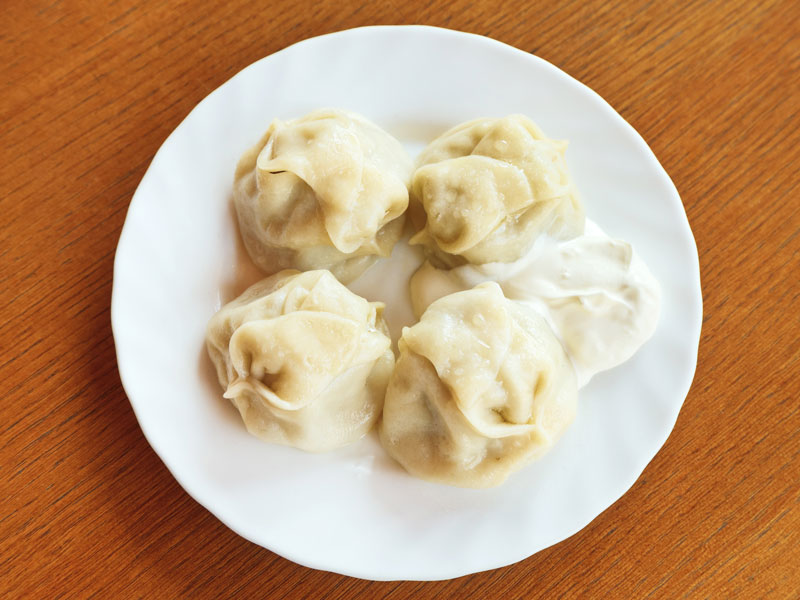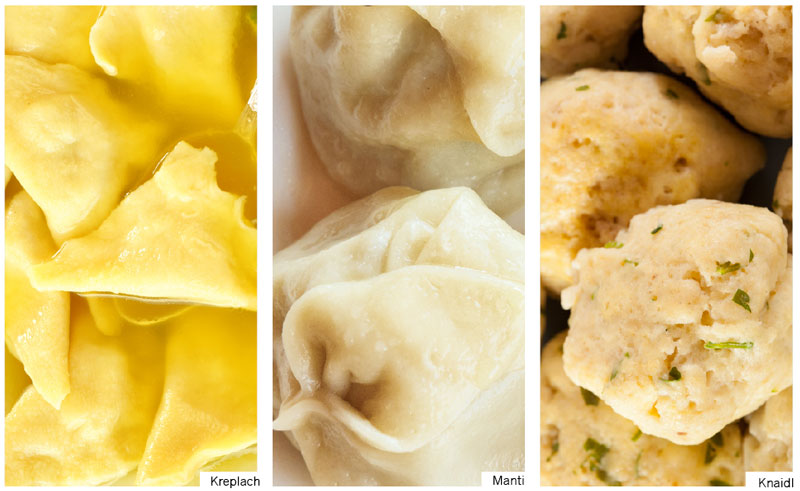

by Tami Weiser
Dumplings are often considered a humble dish, one that makes use of food scraps or stretches leftovers. But as Andrea Nguyen, author of Asian Dumplings: Mastering Gyoza, Spring Rolls, Samosas, and More, puts it, “All dumplings are magical transformations of everyday ingredients.” Their seemingly modest appearance belies their multicultural significance, manifold incarnations and long history.
Food historians shy away from any clear timeline of the development of dumplings; most believe they were both invented independently in many places and influenced by the cuisines of conquerors. But archaeological evidence from the Xinjiang province in northwestern China shows that wheat-wrapped meat dumplings have been around since at least the third century BCE. The late Gil Marks writes in the Encyclopedia of Jewish Food that a northern Chinese steamed, filled bun called mantou, meaning “savage’s head,” later became European filled pasta. But whatever their origins, dumplings have long been universal. “Anywhere you find wheat, you will find people boiling it and eventually figuring out how to make thin sheets and either wrap, fill, boil or bake them,” says Ken Albala, a professor of history and food studies at the University of the Pacific.
The Jewish dumpling’s tale is obscured by the complex history of the Jews—the expulsions and the resettlements and the sheer breadth of their migrations. But wherever Jews found themselves, they adapted the local food for their own, sharing them with Jews from other lands as they traveled. “Jewish dumplings…developed a distinct identity through the interaction of Jewish communities,” writes Barbara Gallani in Dumplings: A Global History.
Among the most beloved of Jewish dumplings are kreplach made of a thin pasta-like dough, folded neatly and usually filled with a minced meat. These Ashkenazi dumplings have appeared in various incarnations across many European countries and maintained their popularity there since medieval times. Steaming chicken soup with tender kreplach welcomed Polish Jews to the holidays, while German Jews ate their own versions of steamed sweet, fruit-filled germknödel or dampfnudel. Russian Jews and their neighbors boiled small pelmeni, a pasta-style dough filled with meat. Central Europeans, Jews and Gentiles alike, adored Polish pierogi (and the Ukrainian version, vareniki)—large dumplings, boiled and sautéed, filled with sauerkraut, potatoes and even sweet cherries.
In ancient Persia, Jews made gondi, a chickpea and meat dumpling—served every Friday night, notes Reyna Simnegar, author of Persian Food from the Non-Persian Bride. In some cases, the dumplings were not seen as particularly Jewish, but the fillings were. The “eggplant filling of the Jews of Turkey, the mashed chickpeas and chicken of Iraqi Jews” were viewed as distinctly Jewish, writes Claudia Roden in The Book of Jewish Food: An Odyssey from Samarkand to New York.
The Jews of ancient Bukhara—which today comprises parts of several modern central Asian nations—embraced another filled dumpling tradition. These Jews “were totally integrated into the central Asian landscape,” says cultural anthropologist Alanna E. Cooper, assistant professor of Jewish studies at Case Western Reserve University and author of Bukharan Jews and the Dynamics of Global Judaism. That culinary landscape included the most ancient of dumplings, manti—a large dumpling made from a pasta or wonton-style dough, wrapped in a distinctly shaped square packet, filled with meat and cooked in stacked steamers. Manti was likely a very early, local iteration of the Mongol or Turkic dumpling, which spread to Korea and west through Turkey and into the Mediterranean by the time of the Ottoman empire. Although most manti are served with dairy sauces, Bukharan Jewish manti are unaccompanied and dairy-free.
The most iconic Jewish dumpling of all is the knaidl, Yiddish for “matzah ball”—a mixture of ground matzah, eggs and fat generally served as a drop-style soup dumpling. The matzah ball emerged from the German, Czech and Austrian tradition of flour and breadcrumb soup dumplings. Once made kosher, they became popular throughout Eastern Europe’s Jewish community and the Pale of Settlement, “epitomizing the robust peasant-and-poor-man’s-food,” according to Roden. (A stuffed version, gefüllte klöese, graced German-Jewish family tables.) Soaking up delicious golden chicken soup, these simplest of dumplings were simultaneously homey and sustaining. With the large migrations of mostly poorer Ashkenazim around the turn of the 20th century, matzah balls, made from cheap and readily available ingredients, became the queen of Jewish food in North America.
Today, matzah balls are served at nearly every American diner and Passover table, and kreplach can be found in the freezers of kosher groceries, but other Jewish dumplings have all but disappeared. Still, of all the eras to be a dumpling, this decade is shaping up to be more than decent. At the end of 2016, New York magazine compiled a list of 50 of the best dumplings in the city, bemoaning the paltry number as “an infinitesimal drop in the dumpling bucket.” The Food Network and the Travel Channel take tours of the best dumpling spots in the country, from potstickers in New Orleans to the decidedly treif bacon cheeseburger dumpling offered at Portland’s Dump Truck. Lest you’re concerned that the trendy is crowding out the traditional: Tucked away amid the salted duck-yolk custard and brown-butter foam in New York’s compendium are plenty of Jewish standbys. In the number-11 entry—kreplach from Sarge’s on Third Avenue—the writers breathlessly declare that in another world, “pasta lovers would define ravioli as ‘Italian kreplach’ instead of the other way around.”
Recipe
Steamed Bukharan-Style Manti
Central Asian Steamed Beef Dumplings, Yields 24 Large Dumplings
Ingredients
3 tablespoons canola or peanut oil
2¼ pounds boneless beef, well-marbled chuck or rib preferred, cut into 1/8-inch dice
2 large onions, peeled, cut into 1/8-inch dice
1½ teaspoons kosher salt
¾ teaspoon freshly ground black pepper
Optional flavorings
1 teaspoon ground cumin, roasted preferred,
2 tablespoons minced fresh cilantro or dill
24 egg-roll wrappers
Preparation
Note: This simplified version uses store-bought egg-roll wrappers in lieu of handmade dough. The fanciful Central Asian folding technique is traditional and looks polished with just four pinches. The traditional filling is simply onions and meat or pumpkin, with salt and pepper, but for food-savvy eaters, try one of the optional ingredients.
1. If using a metal steamer, brush each rack liberally with oil. If using a bamboo steamer, line with parchment paper and brush the paper lightly with oil. Place the steamer near the work surface. Use a stacking steamer.
2. Combine the meat, onions, salt, pepper and optional additions in a bowl. Mix until fully blended.
3. Place an egg-roll wrapper on the work surface. (Cover the remaining wrappers with plastic wrap to prevent them from drying out.) Scoop about two tablespoons of the filling into the center of the wrapper and fold the sides up into an open box shape. Fold two opposite corners up and over the meat and pinch the points together at the center of the dumpling. Fold the two remaining corners over the other layer and pinch the points together.
4. Grasp two adjacent points, gently bend outward, and press together. Repeat with the two other points.
5. Place the dumpling on the prepared steamer tray and cover lightly with plastic wrap. Make the remaining dumplings.
6. Add water to the bottom portion of the steamer, bring to a boil and reduce to a simmer. Stack the filled steamer trays on the steamer bottom, ensuring they aren’t submerged, cover well and steam for about 30 minutes, until the manti have puffed slightly, the dough has become translucent and the meat is cooked. Serve immediately. The bottom batch will cook fastest, so serve manti from the bottom first, removing the emptied racks and moving the top racks to the bottom.
Storage Tip:
Cooked manti do not keep well and should be eaten shortly after steaming. You can freeze the uncooked manti, wrapped well, for up to a week and steam them frozen, but allow more time for them to cook.

